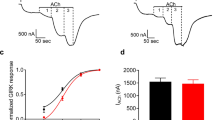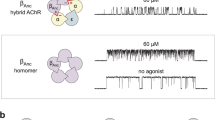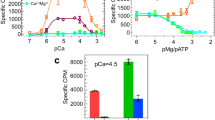Abstract
Binding of acetylcholine (ACh) to cardiac muscarinic ACh receptors (mAChR) activates a potassium channel that slows pacemaker activity1–3. Although the time course of this activation suggests a multi-step process with intrinsic delays of 30–100 ms4–6 no second-messenger system has been demonstrated to link the mAChR to the channel. Changes in cyclic nucleotide levels (cyclic AMP and cyclic GMP) do not affect this K channel or its response to muscarinic agonists7,8. Indeed, electrophysiological experiments argue against the involvement of any second messenger that diffuses through the cytoplasm9. We report here that coupling of the mAChR in embryonic chick atrial cells to this inward rectifying K channel requires intracellular GTP. Furthermore, pretreatment of cells with IAP (islet-activating protein from the bacterium Bordetella pertussis) eliminates the ACh-induced inward rectification. As IAP specifically ADP-ribosylates two GTP-binding proteins, Ni and No, that can interact with mAChRs10, we conclude that a guanyl nucleotide-binding protein couples ACh binding to channel activation. This represents the first demonstration that a GTP-binding protein can regulate the function of an ionic channel without acting through cyclic nucleotide second messengers.
This is a preview of subscription content, access via your institution
Access options
Subscribe to this journal
Receive 51 print issues and online access
$199.00 per year
only $3.90 per issue
Buy this article
- Purchase on SpringerLink
- Instant access to full article PDF
Prices may be subject to local taxes which are calculated during checkout
Similar content being viewed by others
References
Loewi, O. & Navratil, E. Pflügers Arch. ges. Physiol. 214, 678–688 (1926).
Trautwein, W. & Dudel, J. Pflügers Arch. ges. Physiol. 266, 324–334 (1958).
Giles, W. R. & Noble, S. J. J. Physiol., Lond. 261, 103–123 (1976).
Hill-Smith, I. & Purves, R. D. J. Physiol., Lond. 279, 31–54 (1978).
Osterrieder, W., Yang, Q.-F. & Trautwein, W. Pflügers Arch. ges. Physiol. 389, 283–291 (1981).
Nargeot, J. et al. J. gen. Physiol. 79, 657–678 (1982).
Trautwein, W., Taneguchi, J. & Noma, A. Pflügers Arch. ges. Physiol. 392, 307–314 (1982).
Nargeot, J., Nerbonne, J. M., Engels, J. & Lester, H. A. Proc. natn. Acad. Sci. U.S.A. 80, 2395–2399 (1983).
Soejima, M. & Noma, A. Pflügers Arch. ges. Physiol. 400, 424–431 (1984).
Florio, V. A. & Sternweis, P. C. J. biol. Chem. 260, 3477–3483 (1985).
Hamill, O. P., Marty, A., Neher, E., Sakmann, B. & Sigworth, F. J. Pflügers Arch. ges. Physiol. 391, 85–100 (1981).
Matteson, D. R. & Armstrong, C. M. J. gen. Physiol. 83, 371–394 (1984).
Noble, D. J. Physiol., Lond. 353, 1–50 (1984).
Sakmann, B., Noma, A. & Trautwein, W. Nature 303, 250–253 (1983).
Giles, W. R. & Noble, S. J. J. Physiol., Lond. 261, 103–123 (1976).
Noma, A. & Trautwein, W. Pflügers Arch, ges. Physiol. 377, 193–200 (1978).
Momose, Y., Giles, W. & Szabo, G. Biophys. J. 45, 20–22 (1978).
Halvorsen, S. W. & Nathanson, N. M. Biochemistry 23, 5813–5821 (1984).
Hazeki, O. & Ui, M. J. biol. Chem. 256, 2856–2862 (1981).
Kurose, H. & Ui, M. J. Cyclic Nucleotide Protein Phosphoryl. Res. 9, 305–318 (1983).
Sternweis, P. C. & Robishaw, J. D. J. biol. Chem. 259, 13806–13813 (1984).
Nathanson, N. M. J. Neurochem. 41, 1545–1549 (1983).
Sekura, R. D., Fish, F., Manclark, C. R., Meade, B. & Zhang, Y. J. biol. Chem. 258, 14647–14651 (1983).
Author information
Authors and Affiliations
Rights and permissions
About this article
Cite this article
Pfaffinger, P., Martin, J., Hunter, D. et al. GTP-binding proteins couple cardiac muscarinic receptors to a K channel. Nature 317, 536–538 (1985). https://doi.org/10.1038/317536a0
Received:
Accepted:
Published:
Issue Date:
DOI: https://doi.org/10.1038/317536a0



